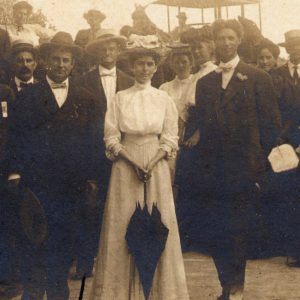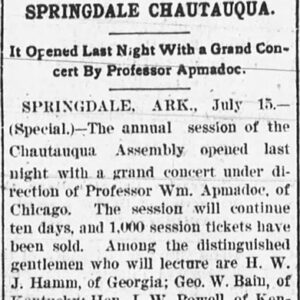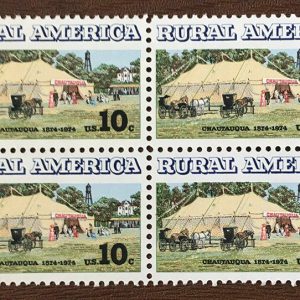calsfoundation@cals.org
Chautauqua
The Chautauqua movement, in the form of traveling “Circuit Chautauquas,” provided self-enrichment and cultural programs for Americans across the country in the early twentieth century. In an era before widespread electronic sources of news and entertainment such as radio, Chautauqua allowed people who lived beyond large cities to experience lectures on a variety of subjects, as well as theatrical offerings and music ranging from Metropolitan Opera stars to bell ringers. U.S. President Theodore Roosevelt called Chautauqua “the most American thing in America.” Governor Charles Brough of Arkansas, himself a popular circuit lecturer, said, “Chautauqua is America’s summer school.” Xenaphon Overton Pindall, who served as acting governor of Arkansas from 1907 to 1909, was also a popular circuit speaker. The name Chautauqua comes from Lake Chautauqua in New York, where the first Chautauqua assembly was held in 1874.
Circuit or “tent” Chautauquas had their genesis in the Lyceum movement, which started in Massachusetts as early as 1826. After adopting much of the Lyceum format, the Circuit Chautauqua experience became noted for stimulating thought and discussion on significant political, social, and cultural issues of the day. In rural states such as Arkansas, it was a vital form of both education and entertainment. While a Circuit Chautauqua program might occasionally be held in an indoor venue (for special occasions or in poor weather, for instance), usually it was held outdoors under a large tent.
The Chautauqua movement began in upstate New York during the late nineteenth century and has continued through the present. Today’s Chautauqua Institution, named for its location on Chautauqua Lake in southwestern New York, is a 750-acre nonprofit lakeside educational center. Each year, thousands of participants pursue art, dance, lectures, music, theater, writing, and special-interest topics.
The first Chautauqua assembly was organized in 1874 by Methodist minister John Vincent and businessman Lewis Miller. They established a camp on the shores of Chautauqua Lake in the Finger Lakes region near Jamestown, New York. There, they trained Sunday school teachers in the pastoral outdoor setting. To improve Sunday school teaching in general, they formulated what they called the Uniform Lesson Plan and founded the Chautauqua Lake Sunday School Assembly.
After the Civil War, programs to educate American adults were fashionable. People were encouraged to use their leisure time in healthy, moral ways rather than for pastimes such as drinking or gambling. Through the late nineteenth and early twentieth centuries, Chautauqua programs filled a desire for self-improvement and entertainment, becoming an extremely popular part of American life. Circuit Chautauquas brought notable speakers and entertainers to small towns, which prided themselves on attracting Chautauqua visits. Often, outlying rural families would come by wagon or short rail lines to sit under the Chautauqua tent in the nearest town. In Arkansas, Circuit Chautauquas became a much anticipated presence, as they did in thousands of American communities.
Building on the success of the New York Chautauqua, smaller “daughter Chautauquas” were presented around the country, giving rise to what was called the Chautauqua Movement. The term “Chautauqua” essentially became a brand name known for high quality (although use of the name was unregulated). The Redpath Lyceum Bureau, which became the Redpath Chautauqua, traveled the United States by railroad, covering Arkansas, Colorado, Illinois, Indiana, Kansas, Kentucky, Michigan, Missouri, Nebraska, Ohio, Oklahoma, South Dakota, Tennessee, Texas, Wyoming, and the Gulf States. Though several smaller circuits also served Arkansas, Redpath was the largest and most prestigious.
After getting off the train in each town, the troupe would unload its brown tents (the color having been chosen to hide dirt). Members of the troupe would then deliver three- to seven-day presentations before moving on to the next town on the circuit.
Chautauqua’s popularity began to decline in the 1920s, due largely to emerging entertainment and news options. However, it remained popular through the early 1930s in isolated rural areas of states like Arkansas, which did not have access to the cultural resources of large cities or electricity to power home radios. Traveling programs in the arts, academic subjects, and physical education were added to Chautauqua’s traditional ecumenical base of spiritual and moral growth.
Some programs borrowed the name, since the word “Chautauqua” set a standard for excellence. In Arkansas, for example, the Chautauqua Assembly of Arkansas was held in Siloam Springs (Benton County) starting in 1885. According to newspaper reports, the two-week session of the Chautauqua Assembly of Arkansas attracted 2,000 people to the opening exercises. Assisted by the local clergy, the program’s manager and leading lecturer was a Dr. Cowe of Iowa. The local newspaper called him “one of the most talented ministers in the South or West.” Another important Arkansas figure in the Chautauqua movement was Frederick Wallace Bartell of Siloam Springs, who organized Associated Chautauquas. This was among the first of the traveling Chautauqua circuits.
In 1904, Arkansas’s Episcopal bishop, William Montgomery Brown, called for an institution of higher learning to be known as the School of Theology of the Diocese of Arkansas, also known as the Arkansas Theological Chautauqua School. According to the Episcopal Church, it was to be housed at the University of Arkansas (UA) in Fayetteville (Washington County). Its mission was to educate a group of “competent men who can and will work at the beginning on small salaries.” While about twenty young men eventually graduated from the program, there remain no further existing records of the school, which reportedly ceased to exist in 1913.
In 2001, the Arkansas Museum of Natural Resources (AMNR) in Smackover (Union County) initiated a successful contemporary Chautauqua. It is generally held for about three days in early June and has an annual theme. At the annual Natural State Chautauqua, living-history characters bring the past to life. To honor the Civil War Sesquicentennial, for example, actors portrayed characters from that era, covering the causes, war years, and Reconstruction. Other themes at AMNR’s Chautauqua have included the American West, colonial America, entertainment, literary influences, the Louisiana Purchase, southern voices, sports, the 1920s and 1930s, and World War II. For the fifteenth anniversary year, the People’s Choice theme allowed the audience to vote on who would return. According to AMNR officials, attendance averages 200 per night. Scholars come to Arkansas from around the country to present their characters under the Chautauqua tent in the evenings and to hold daily workshops.
For additional information:
Episcopal Church. “Arkansas Chautauqua School.” https://www.episcopalchurch.org/glossary/arkansas-theological-chautauqua-school/ (accessed January 31, 2024).
Chautauqua: An American Narrative. PBS Films. http://www.pbs.org/video/1786735759/ (accessed January 31, 2024).
Chautauqua Institution. https://www.chq.org/ (accessed January 31, 2024).
Harrison, Harry P. Culture under Canvas: The Story of Tent Chautauqua. Norwalk, CT: Hastings House, 1958.
Horner, Charles F. Strike The Tents: The Story of the Chautauqua. N.p.: Ulan Press, 2012.
Simpson, Jeffrey, and Paul Solomon. Chautauqua: An American Utopia. New York: Harry N. Abrams, 1999.
Vincent, John Heyl, and Lewis Miller. The Chautauqua Movement. Boston: Chautauqua Press, 1885. Online at https://archive.org/details/chautauquamovem00millgoog (accessed January 31, 2024).
Nancy Hendricks
Garland County Historical Society
 Arts, Culture, and Entertainment
Arts, Culture, and Entertainment Early Twentieth Century, 1901 through 1940
Early Twentieth Century, 1901 through 1940 Fred Bartell
Fred Bartell  Chautauqua Article
Chautauqua Article  Chautauqua Building
Chautauqua Building  Chautauqua Stamps
Chautauqua Stamps  Circuit Chautauqua
Circuit Chautauqua 




Comments
No comments on this entry yet.